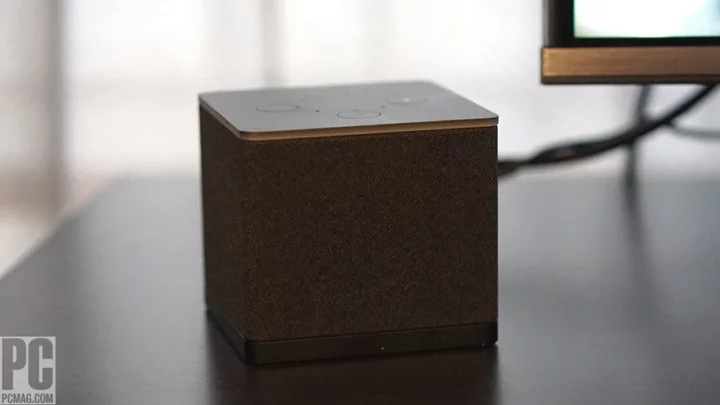Editors' Note: This is the most recent version of the Amazon Fire TV Cube. Read our original review from October 25, 2022 below.
The $139.99 Amazon Fire TV Cube is unique among media streamers thanks to its hands-free voice control. Most media hubs include some form of voice assistant or search, but the Fire TV Cube is the only one to let you use that assistant without requiring a remote. The third-generation, 2022 model of the Fire TV Cube looks a bit different and has a few internal upgrades, but ultimately delivers the same hands-free media hub experience we've come to expect. The only real complaint we have is that it’s nearly three times the cost of the Amazon Fire TV Stick 4K ($49.99) and the Chromecast With Google TV 4K ($49.99). But considering its unique hands-free functionality, the third-gen Fire TV Cube earns our Editors’ Choice for high-end media streamers.
A Softer Cube
While it’s still a cube, the 2022 Fire TV Cube looks markedly more like a spherical Amazon Echo speaker than before. Amazon replaces the glossy black plastic sides of the outgoing model with grille fabric similar to the kind found on its Echo speakers. The fabric softens the 3.0-by-3.4-by-3.4-inch (HWD) cube's sharp right angles and lends it a friendlier look.
The top of the cube is still covered by a matte black plastic panel that hosts four pinholes for the far-field microphone array and a set of four buttons including action, mic mute, and volume up and down. A light runs along the edge of the panel, glowing blue when Alexa is listening and pointing in the direction from which it detects your voice.
The back of the Fire TV Cube has a surprising addition. The standard power adapter port, HDMI output, USB port, Ethernet port, and 3.5mm jack (for the optional $14.99 infrared IR extender) are there—and they’re joined by an HDMI input. This input lets you connect another device, like a game console or a set-top box, to your TV through the Fire TV Cube. The Cube then provides an Alexa overlay on top of whatever is connected.
The remote is slightly more complex than those of normal Fire TV Sticks. The glossy, circular navigation pad sits near the top, with Alexa and power buttons and the pinhole microphone above it. Menu and playback buttons sit directly below the pad. Farther down you'll find the volume rocker and mute button, which are joined by a channel rocker and then TV, settings, and recent content buttons. Finally, dedicated service buttons for Amazon Prime Video, Disney+, Hulu, and Netflix sit near the bottom.
Wi-Fi 6E Tops Spec Upgrades
Internally, the Fire TV Cube features an octa-core processor with 2GB of RAM and 16GB of onboard storage that Amazon says is twice as fast as the Fire TV Stick Max. It outputs video at up to 4K60, and supports high dynamic range (HDR) content in Dolby Vision, HDR10, HDR10+, and hybrid log gamma (HLG).
Surprisingly, it supports 6GHz Wi-Fi 6E (802.11ax) in addition to 2.4 and 5GHz 802.11a/b/g/n/ac. Wi-Fi 6E is nice on paper, but as we witnessed with Wi-Fi 6 on the Fire TV Stick Max and the comparatively modest bandwidth needs of 4K HDR video, 6E won’t noticeably improve the quality of what you watch beyond what a Wi-Fi 5 connection provides. Wi-Fi 6E can potentially improve cloud gaming performance (like with Amazon Luna), but with Xbox Cloud Gaming not yet available on Fire TV and Stadia shutting down next year, your options beyond Amazon’s own cloud gaming service are limited.
The Cube also has Bluetooth 5.0, which is a bit outdated at this point, to connect headphones, game controllers, and other devices.
Fire TV and Hands-Free Alexa
The Fire TV Cube uses Amazon’s Fire TV media streaming platform, which is a powerful, feature-filled interface thanks in part to Alexa. While it’s obviously Amazon-centric (Amazon Prime subscribers have access to Prime Video and Music Prime via the home screen), Fire TV also supports Apple TV, Crunchyroll, Disney+, HBO Max, Hulu, Netflix, Paramount+, Twitch, and YouTube. It’s weak with respect to local media streaming, however; it supports Miracast/WiDi but lacks both Apple AirPlay and Google Cast, which are easily found on competing platforms. AirPlay and Cast make it far simpler to stream or manage content playback from your mobile device.
You can pin your favorite six apps to a quick-launch bar in the middle of the home screen. Buttons to the left allow you to see what's on live TV across a variety of services, including Freevee, Pluto TV, Sling TV, and Tubi. What you watch will also aggregate in the Recent row on the home screen and can also be brought up by pressing the Recents button on the remote. Fire TV supports individual user profiles, so different people in your household can enjoy their own favorites and viewing histories.
The HDMI pass-through feature adds some Alexa functionality to content you push from a secondary source through the Fire TV Cube. Information pop-ups will appear, for example, and the TV screen will feature the glowing blue bar across the bottom when Alexa is listening.
The Cube provides full access to Amazon’s Alexa voice assistant, which you can use without the remote. This is the Cube's biggest advantage over the smaller and cheaper Fire TV Sticks. The far-field microphones let you say, “Alexa,” followed by a command to seek general information or perform specific actions. On the most basic level, this lets you control the Fire TV Cube itself to search for content, open apps, and even navigate on-screen menus. Menu navigation via voice is a bit clunky compared with using buttons, but that’s why a conventional remote is included; content and app control, however, are both easy to manage with Alexa.
All of Alexa's normal features are available. You can make phone calls to any standard (not toll-free, premium, or emergency service) phone number, speak to any Alexa user through their Alexa device, speak to Alexa users on their phone via the Alexa mobile app, and even talk over Skype. If you have a compatible webcam, you can make video calls through Alexa Drop In and Skype; Zoom support will be added in the future.
Perhaps the most useful aspect of Alexa on the Fire TV Cube is its ability to control your smart home. Alexa supports all major smart device brands, spanning hundreds of doorbell cameras, security cameras, smart lights, smart locks, smart plugs, and smart thermostats. Some doorbells and cameras, like Amazon’s own Ring products, can even send video feeds directly to the Fire TV Cube when you ask Alexa to do so.
Quick and Sharp
We've hardly complained about any Fire TV products when it comes to performance, and the Fire TV Cube is unsurprisingly responsive. Obviously, content loading speeds will depend on your internet connection, but navigating menus, using Alexa, and switching between most apps is snappy. There were a few seconds of waiting when loading Sling TV, but that’s about it.
Video quality is consistently strong. 4K video in both Dolby Vision and HDR10 loaded quickly and reliably across all apps that support it, and both The Lord of the Rings: The Rings of Power on Amazon Prime Video and House of the Dragon on HBO Max looked great. It occasionally took up to 10 seconds for the video quality to stabilize at 4K while the apps calculated if the required bandwidth was available, but after that short wait shows looked crisp and accurate.
A Pricey, Feature-Packed Media Hub
The third-generation Amazon Fire TV Cube is an impressive media streamer with better connectivity than ever. It's quick to navigate, includes plenty of features, and is still the only media streamer to offer hands-free voice control. The updated Wi-Fi radio won’t necessarily improve your viewing experience, but it makes the potential for cloud gaming a bit better. At $139.99, the Fire TV Cube is the most expensive media streamer currently available, costing even more than the newly updated Apple TV 4K ($129). We’d still like to see it support Apple AirPlay or Google Cast (or both), but that’s the only thing really lacking from the platform in general and the Fire TV Cube in particular. With that in mind, the 2022 Fire TV Cube earns our Editors’ Choice for media streamers. If you don’t need hands-free Alexa and want to save a lot of money, though, both the Amazon Fire TV Stick 4K and the Chromecast With Google TV 4K are worth exploring.









